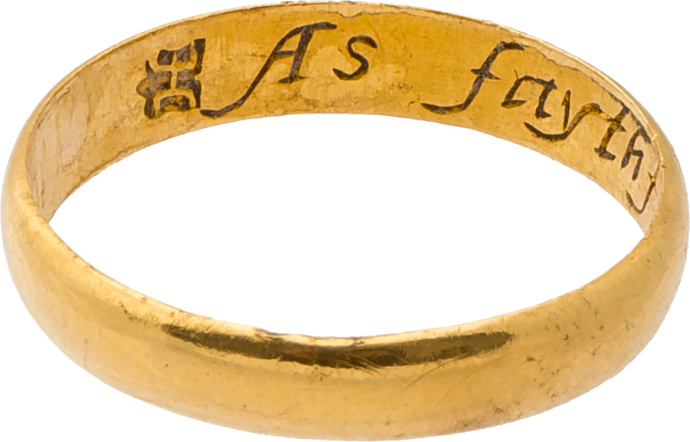Posy Ring As faithful as friendly



Posy Ring “As faythfull as frendly”
, early 17th century


Posy Ring “As faythfull as frendly”
Description
This beautiful posy hides a risqué message that perhaps was shared between two secret lovers.
A plain gold band with D-section and on the interior is the engraved inscription “as faythfull as friendly.” The maker’s mark punch in form of a heraldic shield has the cursive initial ‘H’, which remains yet unidentified. The ring shows signs of wear through age and is in good wearable condition.
Literature:
“Posy rings,” their name deriving from the term poésie or poetry, have mottoes or inscriptions, either in prose or verse. Throughout the sixteenth to the eighteenth centuries rings with posies were increasingly popular. They were exchanged between friends, relatives, and lovers, and at betrothals and wedding ceremonies. Like here, the secret message was often concealed inside the hoop, its content only known to the wearer and giver.
The custom of sending poems with small tokens of affection and of inscribing gifts with short verses led to the poetic compendia or commonplace books and collections, like Loues Garland, or Posies for Rings, Hand-Kerchers, and Gloues, and such pretty Tokens that Louers send their Loues, first published in 1624, Cupids Posies of 1674, and The Card of Courtship of 1715. In fact, the amatory device on this ring “As faythfull as frendly” is found in a commonplace book dated 1596, as recorded by Joan Evans (Evans 1931, p. 20).
For a history of posy rings with extensive list of posies, see Evans 1931 and Anon., A Garland of Love: A Collection of Posy-Ring Mottoes, London 1907. For further information on the history of the ring type, see: Dalton 1912, pp. 174 ff.; Scarisbrick 2007, pp. 74 ff., Taylor and Scarisbrick 1978, and Oman 1974, pp. 39 ff.
